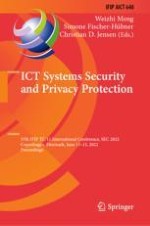2022 | Buch
ICT Systems Security and Privacy Protection
37th IFIP TC 11 International Conference, SEC 2022, Copenhagen, Denmark, June 13–15, 2022, Proceedings
herausgegeben von: Dr. Weizhi Meng, Simone Fischer-Hübner, Dr. Christian D. Jensen
Verlag: Springer International Publishing
Buchreihe : IFIP Advances in Information and Communication Technology
